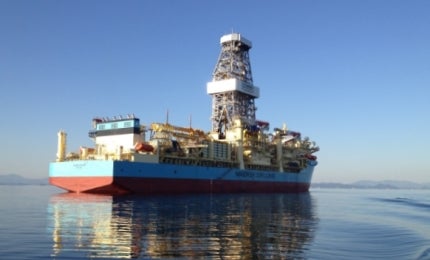
Maersk Voyager is the last of four ultra-deepwater drilling ships built by Samsung Heavy Industries (SHI) for Maersk Drilling. SHI received two contracts worth $2.6bn from Maersk Drilling for the construction of four drilling ships in 2011. The vessels were built at SHI shipyard in Geoje-Si, South Korea.
The naming ceremony of Maersk Voyager was held in September 2014 and delivered was made in February 2015.
Maersk Drilling received a 3.5-year charter contract from Eni Ghana Exploration and Production for Maersk Voyager in March 2015. The $545m contract also includes an option to extend the charter by one year. The vessel, bearing the Singaporean flag, will be deployed at the Offshore Cape Three Points (OCTP) Project in offshore Ghana in July 2015.
Design and features of Maersk’s new drilling vessel
The design integrates a dual derrick, and wide subsea work and storage areas. It is designed to allow effective construction and site development activities through parallel and offline processes.
The ship features a DP-3 dynamic positioning system (DPS). The redundant critical systems enable normal maintenance with no or partial impact on the safety and efficiency of the work.
Maersk Voyager has an overall length of 228m, width of 42m and a depth of 19m. It features a 25.6m x 12.5m moonpool, can operate at a water depth of 3,600m (12,000ft), and can survive a wind speed of 51.5m/s.
It has storage for 2,400m³ of drill water, 1,200m³ of potable water, 6,000m³ of fuel oil, 990m³ of base oil, 750m³ of brine, 452m³ of bulk mud, 452m³ of bulk cement and 480m³ of waste mud.
Maersk Voyager deck equipment and systems
The onboard multi-machine control (MMC) computerised control system along with remotely operated dual pipe handling system allow all standard operations without any workforce on the drill floor. The vessel is also fitted with a large mud storage capacity, riser inspection / maintenance basket and a gas handler.
The travelling system including a travelling block, crown sheaves and main well centre top drive is rated for 1,250t. It allows drilling to depths up to 40,000ft. The main well centre derrick has a rated capacity of 2.5 million pounds (Mlb).
The rig is equipped with 90ft-long MR 6H-SE riser joints rated for a water depth of 12,000ft for efficient marine rise and the blowout preventer (BOP) running. The tensioning system comprises eight dual wire line tensioners with a full top tension of 3.6Mlb.
Norshore Atlantic is a multi-purpose drilling vessel built at the Batam Shipyard in Indonesia by Singapore company Otto Marine.
The ship has four main hydraulic knuckle boom deck cranes, guided gantry cranes and a dedicated pipe handling crane. The mud system is composed of five 5hp mud pumps rated at 7,500psi each.
The mud return system is a dual drilling fluid system, which ensures an efficient shift between mud variety and completion fluids. The mud active system aboard the vessel is equipped with five mixing pumps and four mixing hoppers. The mud pits contain automatic mud chemical additive system and tank washing system.
The drilling ship also features a tubular handling system and an updated power management system with power blackout recovery configuration for recovery in less than 10s.
Accommodation aboard Maersk Voyager
Maersk Voyager offers accommodation for 230 personnel in one-man and two-man cabins. Additional facilities include a canteen, galley, change rooms, recreation rooms, offices and a cinema. Sleeping areas aboard the ship are designed to improve the crew’s working conditions.
Propulsion
Maersk Voyager is powered by six 7,000kW diesel generators and six 5,500kW azimuth thrusters, which provide enough thrust and increased heading control tolerance.







